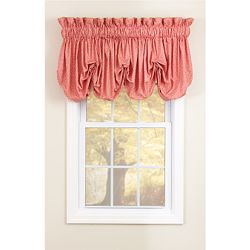Home Staging Tips: Where to Start
/ Think about the last open house you've attended. What do you remember most? The seller probably hopes you say, "the wonderful floor plan!" or, "the gorgeous kitchen!" or, "the beautiful hardwood floors and sunny windows!"
For me, it was the balloon valances.
Think about the last open house you've attended. What do you remember most? The seller probably hopes you say, "the wonderful floor plan!" or, "the gorgeous kitchen!" or, "the beautiful hardwood floors and sunny windows!"
For me, it was the balloon valances.
Now, the house was nice. It was an older ranch, with pristine hardwood floors under the cream-colored carpet, good-sized bedrooms, a big backyard. It had charm and potential. But I didn't see it, because I was too distracted by those valances. They were made of heavy floral fabric and were trimmed with puff-ball fringe. And they were hanging in every single room. Though the home was tidy, the outdated, ill-placed window treatments gave the whole place a sad, dusty, claustrophobic feel. I imagined how bright and new the home would feel, if only someone would tear those valances from their curtain rods.
That's the thing about staging -- a few simple changes (and a few that require a bit of elbow grease) can transform a home so that it's potential can shine. Out with the balloon valances, in with the wow.
Some people bristle when they hear the word "staging". It sounds like a lot of work. Some sellers resist updating things like paint and hardware because they assume buyers would rather make those decisions for themselves. There's some truth to that. But what's even truer is this: No matter how "move-in ready" a home may be, every single buyer will want to do some work to make the home their own. Potential buyers walking through your home often make mental lists of everything they'd need to do to comfortably live there. Proper staging helps to make that mental to-do list as short as possible.
We know, on average, that nicely staged houses sell more quickly and at higher prices. Specific staging how-to's depend on the unique characteristics of your home, but below are few general home staging tips to get you started. (Some of this advice applies to homeowners who aren't selling, too. We've heard more than one seller look around after they've staged, only to wish they'd done at least some of the work a lot sooner, so they could've enjoyed it.) Here goes:
First, clean. It's that simple. Clean your house -- every surface, every baseboard, under every rug. Open the windows and let in a little fresh air. Don't just light a vanilla candle and hope potential buyers don't notice the cat hair ground into the carpet and the decade of dust on the window sills. They will always notice.
Emphasize the positives. What do you love about your home? What are its best features? Stage your home in a way that highlights its biggest selling points and brings out its potential. For example, if you have a bay window, don't shove a bulky couch up against it or cover it up with heavy curtains.
Minimize the drawbacks. As you emphasize what makes your home great, you can de-emphasize some of its less-than-ideal features. For example, my house has a narrow living room and lack of formal entry. Smaller scale furniture arranged just the right way makes the room feel appropriately proportioned; and a well-placed console table and coat hooks create an acceptable alternative to a foyer.
De-clutter. For a quick fix, remove or place out of sight:
- outdated and/or fussy curtains
- artificial flower arrangements
- framed family photographs
- every magnet, photo, and piece of paper affixed to your refrigerator
- all toiletries and personal hygiene products
- trash cans
- half (or more!) of whatever is on your kitchen counter, coffee table, bathroom vanity, and bedroom dresser
Update when really needed. There's likely no need to renovate your entire kitchen just to sell your house (though sometimes that might be what it takes -- but that's for another blog entry). Smaller, less expensive updates can help to depersonalize and modernize your home in ways that will appeal to buyers. For example:
- Remove wallpaper & wallpaper border.
- Re-paint the rooms that really need it -- like the child's bedroom covered in a Disney mural, the neon-yellow bathroom, the front hall painted a flat neutral that shows every scuff and scratch from the past 10 years.
- Update hardware and fixtures that are woefully out of date, marginally functional, and/or don't fit with the style or era of your home.
- Re-caulk any tile and molding, as needed.
Make your rooms photo- and tour-friendly. This is all about furniture placement:
- Arrange your living space so the seating elements face each other -- not the television set. Imagine three or four people visiting in your living room; can they all sit down and comfortably converse?
- Rooms usually feel more spacious when you can see all four corners. Move your furniture (and possibly remove some pieces, if need be) so that all four corners are furniture-free.
- Pay attention to traffic patterns -- can you easily move through each room without having to navigate around large pieces of furniture or squeeze through tight spaces?
When it comes to home staging tips, these are just a starting place. If you're interested in how you might more successfully stage your home, or if you have specific questions, just let us know. We'd be happy to help!

